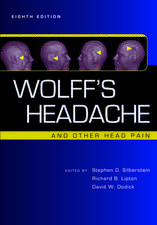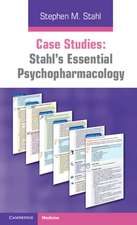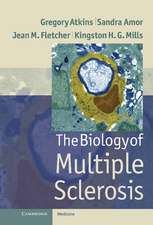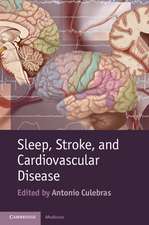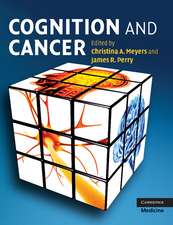Essential Neuropharmacology: The Prescriber's Guide
Autor Stephen D. Silberstein, Michael J. Marmura, Hsiangkuo Yuan Stephen M. Stahlen Limba Engleză Paperback – 14 oct 2015
Preț: 641.87 lei
Preț vechi: 675.64 lei
-5% Nou
122.83€ • 131.34$ • 102.41£
Carte disponibilă
Livrare economică 28 martie-11 aprilie
Specificații
ISBN-10: 1107485541
Pagini: 480
Dimensiuni: 140 x 229 x 29 mm
Greutate: 1.17 kg
Ediția:Revizuită
Editura: Cambridge University Press
Colecția Cambridge University Press
Locul publicării:New York, United States
Cuprins
Introduction; List of icons; Acknowledgements; 1. Acetazolamide; 2. Alemtuzumab; 3. Almotriptan; 4. Alteplase; 5. Amantadine; 6. Amifampridine; 7. Amitriptyline; 8. Apixaban; 9. Apomorphine; 10. Aprepitant; 11. Aripiprazole; 12. Armodafinil; 13. Aspirin (acetylsalicylic acid); 14. Azathioprine; 15. Baclofen; 16. Benztropine; 17. Bevacizumab; 18. Botulinum toxin type A; 19. Botulinum toxin type B; 20. Bromocriptine; 21. Bupropion; 22. Carbamazepine; 23. Carisoprodol; 24. Carmustine; 25. Chlorpromazine; 26. Citalopram; 27. Clobazam; 28. Clonazepam; 29. Clonidine; 30. Clopidogrel; 31. Clozapine; 32. Corticotropin; 33. Cyclobenzaprine; 34. Cyclophosphamide; 35. Cyclosporine (ciclosporin); 36. Cyproheptadine; 37. Dabigatran etexilate; 38. Dalfampridine; 39. Dantrolene; 40. Desvenlafaxine; 41. Dexamethasone; 42. Dextromethorphan/quinidine; 43. Diazepam; 44. Diclofenac; 45. Dihydroergotamine (DHE); 46. Dimethyl fumarate; 47. Dipyridamole/aspirin; 48. Donepezil; 49. Droperidol; 50. Droxidopa; 51. Duloxetine; 52. Edoxaban; 53. Edrophonium; 54. Eletriptan; 55. Entacapone; 56. Escitalopram; 57. Eslicarbazepine acetate; 58. Ethosuximide; 59. Everolimus; 60. Ezogabine; 61. Felbamate; 62. Fingolimod; 63. Flunarizine; 64. Frovatriptan; 65. Gabapentin; 66. Galantamine; 67. Glatiramer acetate; 68. Guanfacine; 69. Haloperidol; 70. Heparin; 71. Intravenous immunoglobulin (iVIg); 72. Indomethacin; 73. Interferon-β (1a and 1b); 74. Lacosamide; 75. Lamotrigine; 76. Levetiracetam; 77. Levodopa and carbidopa; 78. Levomilnacipran; 79. Lidocaine; 80. Lithium; 81. Mannitol; 82. Meclizine; 83. Memantine; 84. Metoclopramide; 85. Metaxalone; 86. Methocarbamol; 87. Methotrexate; 88. Methylergonovine; 89. Methysergide; 90. Mexiletine; 91. Milnacipran; 92. Mirtazapine; 93. Mitoxantrone; 94. Modafinil; 95. Mycophenolate mofetil; 96. Nabiximols; 97. Naratriptan; 98. Natalizumab; 99. Netupitant/palonosetron; 100. Nimodipine; 101. Nortriptyline; 102. Olanzapine; 103. Ondansetron; 104. Oxcarbazepine; 105. Penicillamine; 106. Perampanel; 107. Phenytoin and fosphenytoin; 108. Pizotifen; 109. Pramipexole; 110. Prednisone; 111. Pregabalin; 112. Primidone; 113. Prochlorperazine; 114. Propranolol; 115. Pyridostigmine; 116. Quetiapine; 117. Quinine sulfate; 118. Ramelteon; 119. Reserpine; 120. Riluzole; 121. Rituximab; 122. Rivaroxaban; 123. Rivastigmine; 124. Rizatriptan; 125. Ropinirole; 126. Rotigotine transdermal system; 127. Rufinamide; 128. Sodium oxybate; 129. Sumatriptan; 130. Suvorexant; 131. Tasimelteon; 132. Temozolomide; 133. Teriflunomide; 134. Tetrabenazine; 135. Tiagabine; 136. Timolol; 137. Tizanidine; 138. Topiramate; 139. Trientine hydrochloride; 140. Trihexyphenidyl; 141. Valproic acid and derivatives (DPX); 142. Venlafaxine; 143. Verapamil; 144. Vigabatrin; 145. Vilazodone; 146. Vortioxetine hydrobromide; 147. Warfarin; 148. Zolmitriptan; 149. Zonisamide; List of abbreviations; Index by drug name; Index by use; Index by class.
Recenzii
Descriere
Essential Neuropharmacology: The Prescriber's Guide reviews the full range of medications used by neurologists in clinical practice. Expert knowledge is given about the best use of medications in patient care. Each drug listing contains the full range of indications, their advantages and disadvantages, and tips for dosing and avoiding adverse effects. Evidence is taken from recent clinical trials, which helps the reader relate the drug descriptions to everyday clinical practice. Where appropriate, off-label uses are also described. The detailed descriptions of each medication enable the user to make quick and informed decisions with the confidence they need to serve the clinical needs of their patients effectively. The new edition is fully updated throughout. Major new additions include neuro-oncology drugs, new multiple sclerosis agents, sleep medications and new formulations. This book is an essential, user-friendly reference suitable for neurologists at all stages of their careers.

